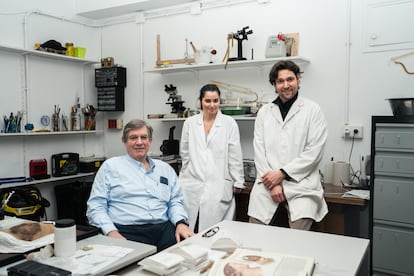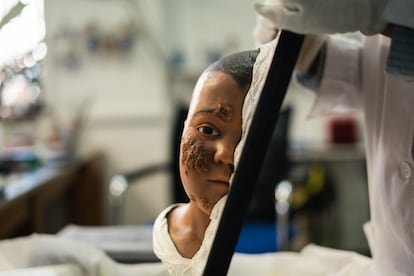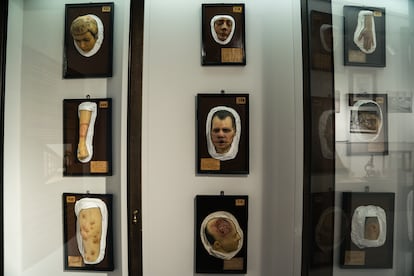The cursed fate of the museum of the world's most unfortunate people: from an aerobics studio to being expelled from the Complutense University

The Complutense University of Madrid has decided to remove from its premises one of the world's most unique collections of medical history, the Olavide Museum , a veritable sanctuary of unusual hyperrealist sculptures. Its origins lie on Madrid's Atocha Street, where a hell on earth existed until 1897. The San Juan de Dios Hospital stood there, specializing in treating poor people with terrifying skin diseases, especially those transmitted sexually, such as syphilis , which preyed on prostitutes. Hundreds of those patients, often turned into sex slaves as children, were immortalized in terrifying wax statues by the father of Spanish dermatology, José Eugenio Olavide , and his colleagues, to teach medicine to his students. There are also beggar children with ringworm, day laborers with psoriasis, bricklayers with leprosy, sewer cleaners with infected wounds, and laundresses with hands destroyed from washing.
The museum's director, dermatologist Pablo Lázaro , is outraged. "I find it unacceptable that a museum of the history of medicine, which is a living demonstration of the teaching method, ends up on the street. It's unacceptable," he laments. The exhibition had previously occupied 560 square meters, loaned by the Complutense University since 2014, in the semi-abandoned basement of the Faculty of Medicine. On May 22, the Spanish Academy of Dermatology and Venereology, custodian of the collection, received an official notification in which the university manager, Ana María Cantalejo , urged the urgent "vacation" of the facilities, "as well as the removal of the objects located there" before the end of the academic year. The Complutense University, stifled by the cuts imposed by Isabel Díaz Ayuso's government, argues that "for economic and organizational reasons" it must dedicate that space to "other academic uses," according to the letter, to which EL PAÍS has had access.
The “objects located there,” as the manager calls them, are more than 670 wax figures of the unfortunate patients of the San Juan de Dios Hospital, which together constitute what is possibly the only museum of sculptures of poor people in the world. The writer and physician Pío Baroja described that mansion in his book The Tree of Science , published in 1911. “The patients were the most fallen and miserable. Seeing so many homeless wretches, abandoned, in a black room, in a human dunghill; seeing and demonstrating the rot that poisons sexual life, made [...] an anguishing impression on him. That hospital, fortunately now demolished, was a filthy, dirty, and foul-smelling building; the windows of the wards overlooked Atocha Street and had, in addition to bars, wire mesh so that the confined women wouldn't lean out and cause a scandal,” Baroja recounted.

The Madrid dermatologist José Eugenio Olavide (1836-1901) and his colleagues were inspired by the wax figure museum at the Hospital of Saint Louis in Paris. The two collections have had divergent trajectories. The Parisian one was officially inaugurated during the 1889 Universal Exposition, like the Eiffel Tower, and remains there, in its impressive original building, as a jewel of medical history. The Spanish one has been floundering for over a century. The first museum opened in 1882 in the already dilapidated Hospital of Saint John of God, which was abandoned in 1897. Hundreds of wax statues of disfigured people then made a procession down Atocha Street, to their next destination, a new building constructed near Retiro Park. When the Francoist authorities decided to demolish it to build the current Gregorio Marañón Hospital there in 1966, the figures were packed into boxes in a dilapidated warehouse and forgotten.
The collection then belonged to the Provincial Council, the predecessor institution of the Community of Madrid. In 2002, a high-ranking official asked the Complutense University's Forensic Anthropology Museum —a diverse exhibition, including Egyptian mummies, human skulls, real-life murder weapons, and even a garrote—to take charge of the wax figures. In 2005, the collection was moved to the headquarters of the Spanish Academy of Dermatology and Venereology in Madrid. And at Christmas of that same year, another 120 boxes containing more sculptures were found at the Niño Jesús Hospital. Conservators David Aranda and Amaya Maruri , who began restoring the figures at the Complutense University as volunteers 21 years ago, describe the incredible journey the collection has taken since then: a storage unit in Torrejón de Ardoz, a hot truck in which some of the figures melted, another stage in a future gym in Chamberí, and a former aerobics studio in Leganés.

The Spanish Academy of Dermatology and Venereology and the Complutense University finally reached an agreement to rescue the Olavide Museum more than a decade ago. The then rector, mathematician Carlos Andradas, presented the reopening in December 2016 as a milestone. “For us, it is a pleasure and a privilege to bring together this collection from the Olavide Museum at the Complutense University, in the best Faculty of Medicine in the country, heir to the first medical study centers. For us, it is also the first step in a project we have long cherished, namely, creating a great Museum of Medicine, in which we bring together the wonderful treasures of our museums and collections,” proclaimed Andradas, who was rector until 2019, when he was succeeded by veterinarian Joaquín Goyache . That Museum of Medicine project quickly died due to lack of budget, personnel, and space, according to a spokesperson for the Complutense University. And the treasure of Spanish dermatology is now left on the street.
“We are not an institution with the financial power to be able to have a space as we please,” explains the museum director. “This has caught us off guard. Couldn't they have spoken to us earlier?” he complains. The agreement between the Academy and the Complutense University expired in 2020, when the COVID pandemic paralyzed humanity. The museum director says he met with Vice-Rector Isabel García Fernández on October 4, 2023, to request an extension, but the agreement was never renewed.

This newspaper visited the Olavide Museum on March 28 to report on its agony in the leaky basement of the Faculty of Medicine. Its location, a kind of abandoned hospital with long corridors, is so gloomy that the Complutense University rents out the neighboring spaces for filming horror movies, for up to 10,000 euros a day. The production company for the American television series The Walking Dead has even expressed interest in the location. Museum officials have recorded three incursions by thieves into this wing of the faculty, including one in which the attackers managed to enter the storage rooms without causing any damage. In September 2019, torrential rains flooded three exhibition halls.
Curators David Aranda and Amaya Maruri explain why the Olavide Museum is unique. The sculptors at Madrid's San Juan de Dios Hospital, they emphasize, did not limit themselves to reproducing the injury in wax, as in Paris, but included a larger portion of each patient, often their face. Aranda and Maruri walk through the museum and rotate some figures 180 degrees. Behind the face is each person's medical record, with their first and last initials. It's an astonishing window into life in 19th-century Spain.

The stories are dramatic, like the one that appears behind the figure of a woman with her tongue out , riddled with ulcers: “NS, 21 years old, single, native of Seville, with a nervous temperament, well-built, with no history of hereditary morbidity: she reported that having had her first menstruation at the age of 12, and leading a licentious life from that date on, she contracted several illnesses: some out of whim or to satisfy a sexual orgasm; others due to her adventurous profession.”
Another sculpture is of a whitish, extremely sad child : "MP, a 7-year-old boy from Madrid, sheltered in the hospice, was admitted to this hospital on June 14, 1881." His head was covered in "small, moist, yellowish scabs, from which an unbearable odor emanated, and the development of parasites coincided with the rash, making the itching even more unbearable and exasperating." The mistreatment their wax statues receive now is trivial compared to the humiliations these people suffered in life.
EL PAÍS





